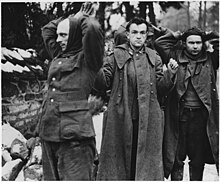Non-combatant

As non-combatants used to describe people from a war or armed conflict are concerned, without being actively involved in the fighting. Depending on the respective terminology, sick or wounded soldiers , surrendering or captured soldiers ( prisoners of war ), members of the armed forces without a combat mission, such as paramedics or military chaplains, civil service providers working on behalf of the military, war reporters , the auxiliary personnel of the National Red Cross and Red Crescent Societies and organizations equivalent to these societies, members of civil protection units and the civilian population .
The term, which is sometimes used differently in legal and colloquial terms and which has been subject to change in terms of its international legal meaning, is differentiated from the combatants actively involved in the fighting . Most non-combatants are subject to the protection of international humanitarian law , but to different degrees depending on their affiliation to one of the groups mentioned. Regardless of this legal meaning of the term, the distinction between combatants and non-combatants is also an essential principle in just war theory .
Legal historical development
From a historical point of view, the differentiation between people affected by a war into non-combatants and combatants began with the formulation of the Dear Code in 1863 and above all with the Brussels Declaration of 1874 . Since then, different definitions of the term “non-combatant” have developed in contractually fixed international law , in customary international law as well as in military-theoretical and ethical discussions. It therefore does not describe a uniform and generally accepted status, but includes different groups of people, each with a specific legal status. The concrete demarcation between combatants and non-combatants is therefore inconsistent and depends on the historical and geopolitical context of the conflict in question.
In the legal conception of the so-called Hague Law, which was authoritative until the end of the Second World War , essentially based on the Hague Land Warfare Regulations of 1899 and 1907, the term non-combatant encompassed members of the armed forces who were not involved in combat operations, as distinct from combatants and civilians. The currently valid legal conception, which is mainly based on the so-called Geneva law, does not have an explicit definition of the term. However, contrary to the Hague Land Warfare Regulations, Article 33 of the first additional protocol to the Geneva Conventions counts all members of the armed forces with the exception of paramedics and pastors as combatants.
Colloquial meaning
Colloquially, those groups of people who are protected by the four Geneva Conventions of 1949 and their Additional Protocols of 1977 are generally referred to as non-combatants. This applies to military and civil auxiliary personnel (paramedics), incapacitated former combatants (status hors de combat - sick, wounded and captured soldiers), and all other persons who are explicitly not combatants and do not take part in combat operations (civilians).
Legal aspects
The majority of the groups of people summarized under the term non-combatants are protected according to the current rules and customs of international humanitarian law , depending on their respective status but to a different extent . The basic principles include the right to human treatment and, above all, protection against all actions that are directed against their life, their health and physical integrity, their honor, and their religious or other convictions. In the case of military activities, a distinction must be made between combatants and non-combatants; the latter are to be spared as far as possible. The relevant international humanitarian law agreements are the Geneva Conventions with their additional protocols.
The military-theoretical assessment of the position of members of the armed forces, for example as part of the armed forces' supply structures, is not directly involved in combat operations, but actively supports them through their activities. Although they are considered combatants in currently relevant international law, since they have the right and the possibility in principle to participate in combat operations, their status is part of the ethical debate on the theory of just war. This also applies to combatants who are temporarily defenseless but who are on active duty, whose treatment is sometimes discussed as the dilemma of the “sleeping soldier” or the “naked soldier”.
literature
- Knut Ipsen: Chapter 3: Combatants and non-combatants. In: Dieter Fleck (Ed.): Handbook of Humanitarian International Law in Armed Conflicts. CH Beck, Munich 1994, ISBN 3-406-38139-1 .
- Nicholas G. Fotion: Combatant-Noncombatant Distinction. Lexicon entry in: Donald A. Wells (Ed.): An Encyclopedia of War and Ethics. Greenwood Press, Westport CT [et al. a.] 1996, ISBN 0-313-29116-0 .
- Otto Kimminich: Protection of people in armed conflicts. On the further development of international humanitarian law. Kaiser Grünewald, Munich et al. 1979, ISBN 3-459-01208-0 , ( Development and Peace - Scientific Series 20).
- Regina Buß: The combatant status. The emergence of a legal term under martial law and its design in the treaties of the 19th and 20th centuries. Brockmeyer, Bochum 1992, ISBN 3-8196-0025-6 , ( Bochum writings on peacekeeping and international humanitarian law 12), (also: Bochum, Univ., Diss., 1992).
- James Turner Johnson: War Against Noncombatants. In: James Turner Johnson: Morality and Contemporary Warfare. Yale University Press, New Haven CT et al. 1999, ISBN 0-300-07837-4 .
- APV Rogers: Combatant Status. In: Roy Gutman, David Rieff (eds.): Crimes of War. What the Public Should Know. WW Norton & Company, New York NY 1999, ISBN 0-393-31914-8 .
Web links
- Literature on the subject of non-combatants in the catalog of the German National Library

